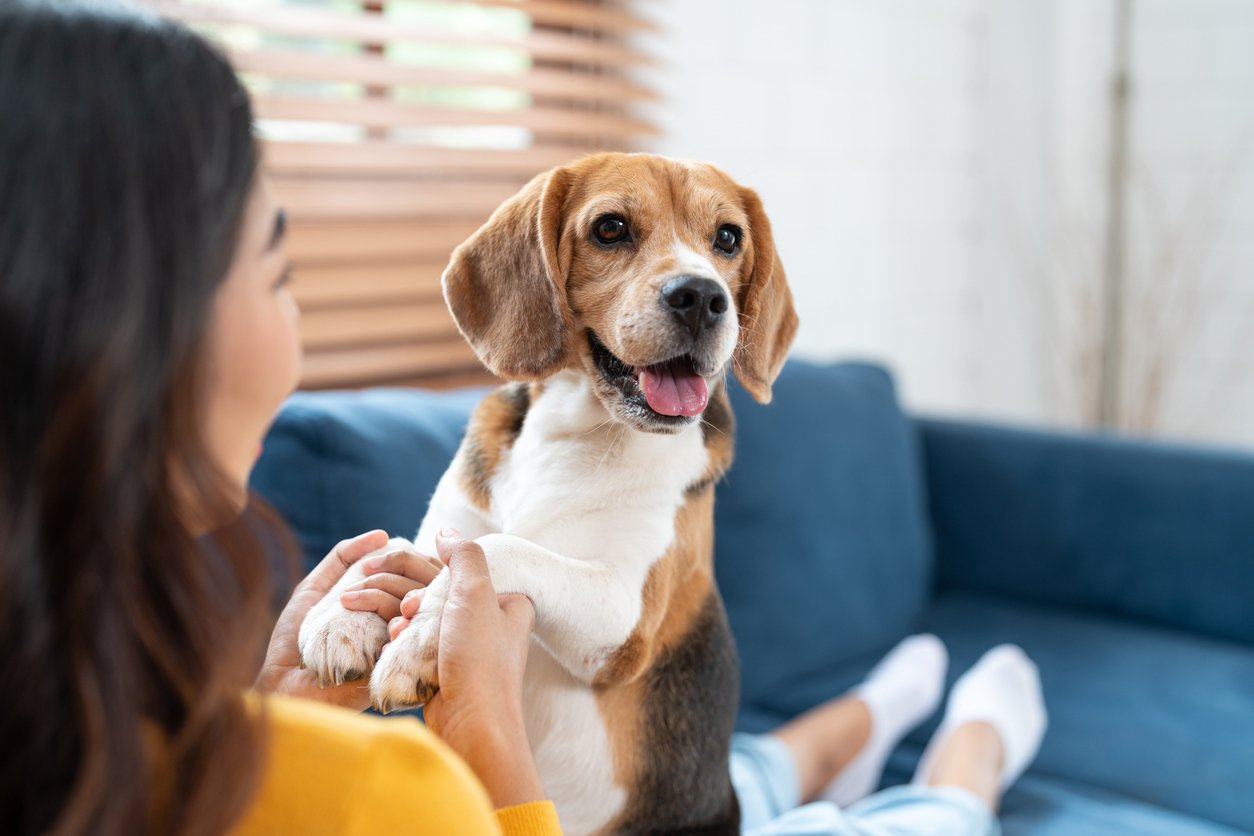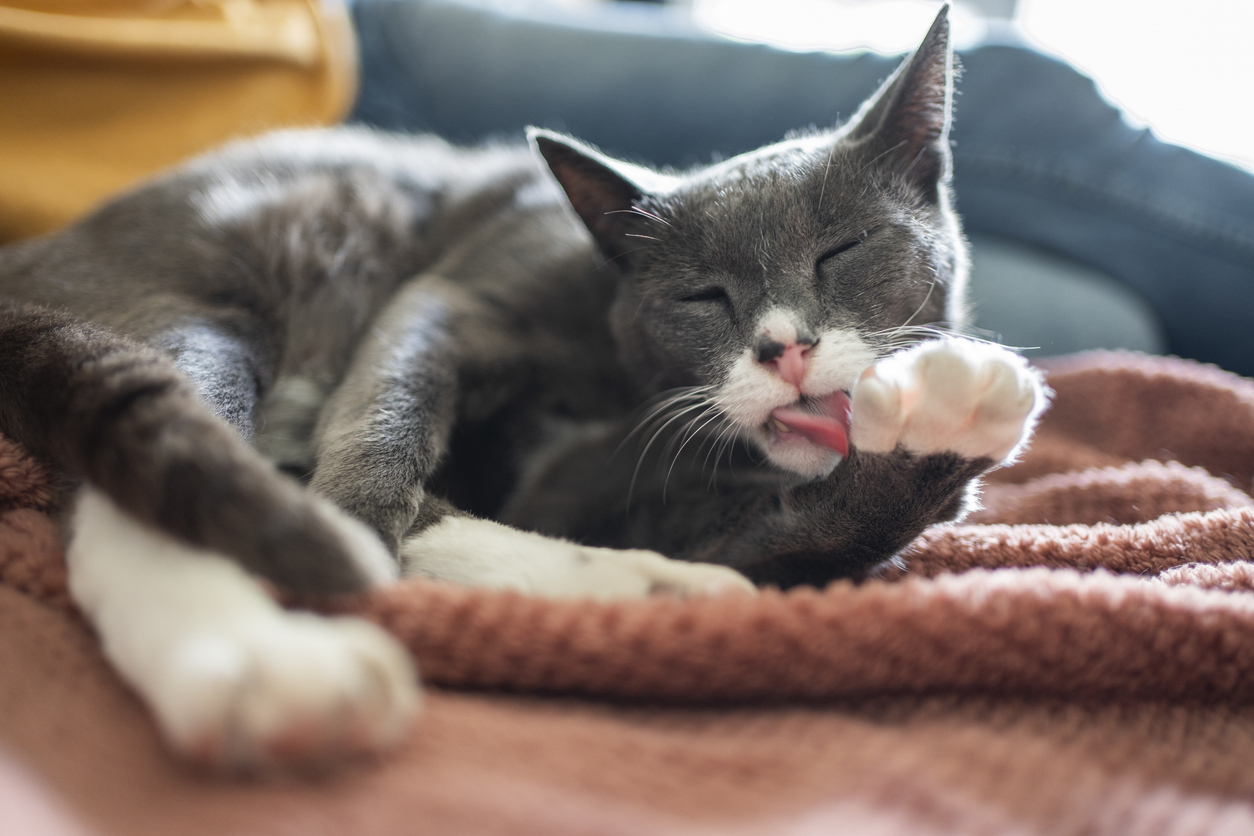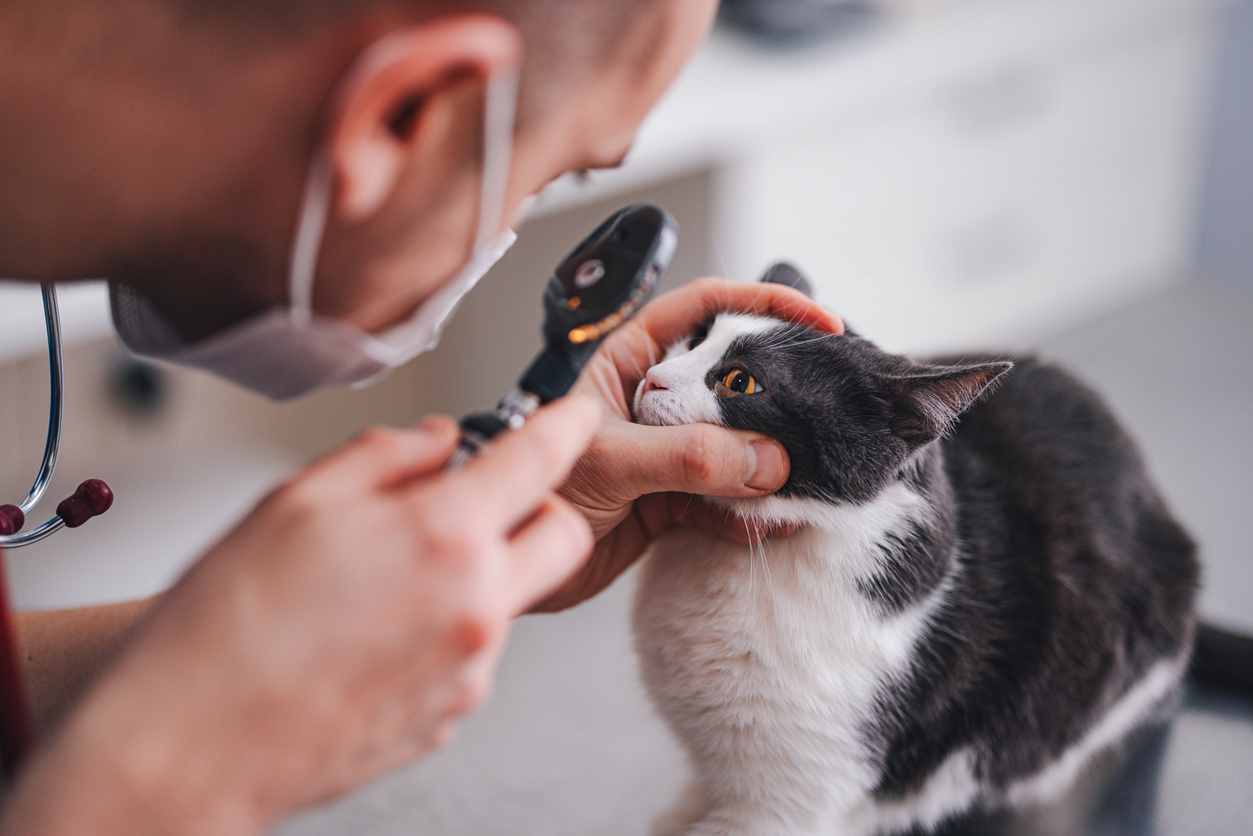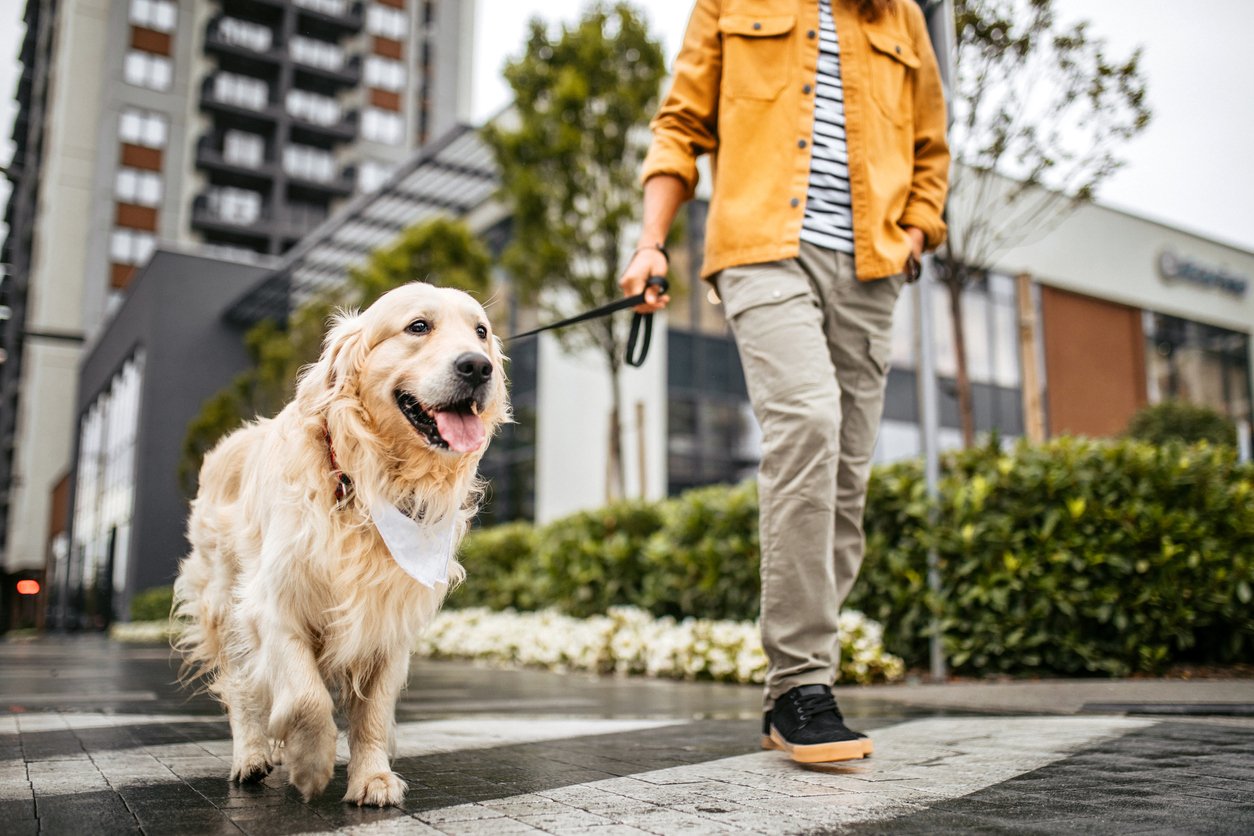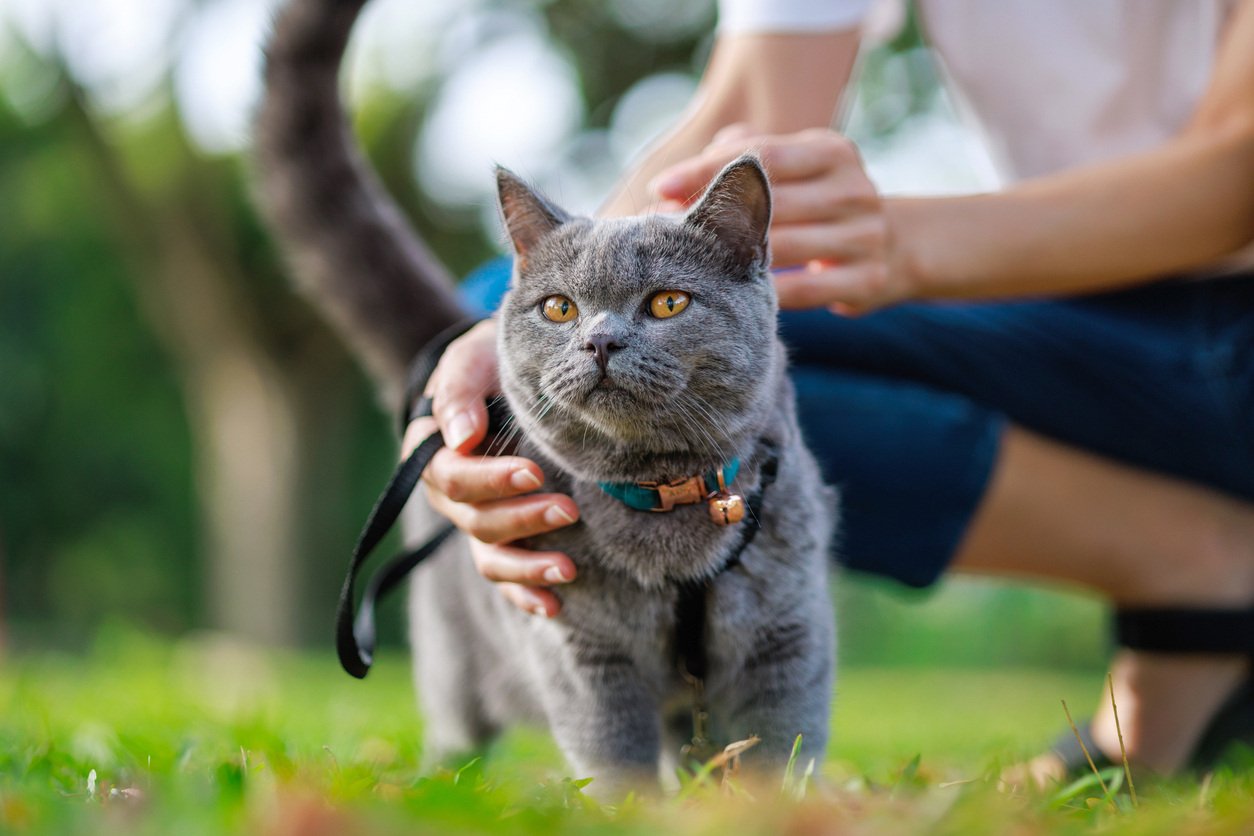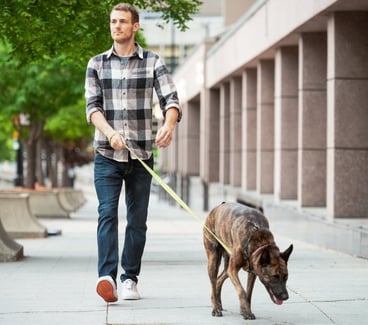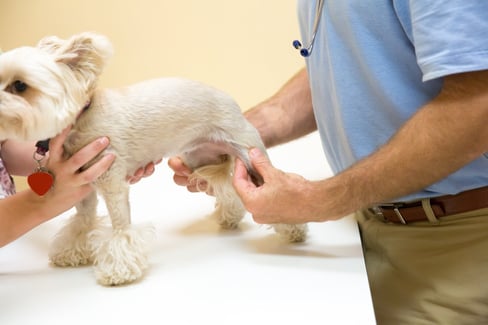Table of Contents
Dogs have an incredible design when it comes to mobility. From the tip of their noses to the pads of their paws, every part has a job to do.
One feature many owners overlook is the small, raised pad halfway up the dog’s front leg, a.k.a., the carpal pad. You might notice it most when your dog is sitting or bounding across rough terrain, but this little pad plays a surprisingly big role in balance, traction, and shock absorption.
Here, we dive into the function of the carpal pad, the most common injuries and conditions that affect it, and the best ways to care for it long-term.
Function and Purpose of a Dog Carpal Pad
The carpal pad is often called the “dog’s brake.” Located slightly above the paw, it doesn’t touch the ground when walking normally but engages when your dog runs, jumps, or lands.
Function
The carpal pad’s functions include:
- Traction: Helps stabilize sharp turns or quick stops.
- Shock absorption: Cushions impact when landing from jumps.
- Braking: Engages during downhill runs to slow momentum.
Carpal Paw Pad Dog vs. Metacarpal Pads
The metacarpal pads (the large central pads under the paw) are the part of the dog paw anatomy that support weight during every step.

On the other hand, the carpal pad dog only activates in more extreme movements. Think of the metacarpal pads as daily sneakers and the carpal pad as a performance cleat that kicks in when the game gets intense.
|
Pad Type |
Location |
Function |
|
Carpal Pad |
Higher up on the front leg |
Traction, braking, shock absorption during speed or jumps |
|
Metacarpal Pads |
Bottom of the paw |
Main weight-bearing pads for walking and standing |
Common Dog Carpal Pad Issues
Because of its location and purpose, the carpal pad is particularly vulnerable to scrapes, tears, and infections. Active and working dogs encounter these problems most often, but even a casual run on rough pavement can lead to trouble.
Dog Carpal Pad Injury: Signs and Causes
Carpal pad injuries aren’t glamorous. They don’t come with a dramatic backstory like “my dog was saving the world and skidded too hard.”
More often, it’s something simple: a sharp rock, a sprint on rough ground, or an overzealous game of fetch that ends with a limp. But while the cause may look minor, the result can be messy, painful, and surprisingly dramatic.
Cuts, Abrasions, and Torn Carpal Pad in Dogs
Imagine tripping on the sidewalk and scraping your palm. Now imagine your palm is the first thing that slams the brakes every time you run.
That’s what happens when your dog tears a carpal pad. These cuts range from mild scrapes that make walking uncomfortable to deep tears that bleed. Because the pad works hardest during stops and turns, even small abrasions can sting every time your dog moves.
Dog Carpal Pad Injury Flap: What It Means and When to See a Vet
One of the more unsettling sights is when a loose flap of pad tissue hangs off after a tear.
A carpal pad injury flap usually needs to be trimmed or sutured by a vet. Leaving it alone can invite infection and drag out recovery, so if you see one, skip the DIY attempts and head straight to the clinic.
Common Causes of Dog Carpal Pad Injuries
Dogs don’t need extreme sports to damage their carpal pads. The everyday stuff does the job just fine:
- Sharp objects like glass, nails, or thorns
- Rough surfaces such as gravel or asphalt
- Overuse from long runs or repetitive play
- High-speed sports like agility or flyball (think of it as CrossFit for dogs — great for energy, rough on joints and pads)
- Infections that start small but snowball when bacteria find their way into an open wound
Infection
Pads are like little dirt magnets. They’re constantly in contact with the ground, which means bacteria are practically waiting for an opening. Once infection sets in, swelling, redness, and discharge follow.
Because the area is hard to keep clean, the wound stays moist and exposed. Dogs don’t help themselves either. Constant licking introduces more bacteria from the mouth, which adds fuel to the fire. Combine that with the pressure and friction of daily movement, and the pad becomes the perfect storm for infection.
Below are symptoms of infection to watch out for:
- Swelling: The area around the pad looks puffier than usual and may feel warm.
- Redness: Healthy tissue turns irritated and inflamed.
- Pus or discharge: A yellow or green fluid that signals bacteria are multiplying.
- Foul odor: An unmistakable smell that’s often the strongest indicator infection is brewing.
- Bleeding: May continue intermittently, since infected tissue is fragile and breaks open easily.
Bleeding
One of the first things owners notice, and panic over, is the sheer amount of blood. Why so much blood? Carpal pads are packed with blood vessels. It’s a design feature: more blood flow means faster healing. The trade-off is that it looks far worse than it often is. Still, heavy or prolonged bleeding is a sign you should step in with first aid, and sometimes a vet.
Here are some first aid steps to follow if you’re dealing with an actively bleeding carpal pad:
- Control the bleeding: Press a clean cloth or gauze firmly against the pad until it slows.
- Clean the wound: Rinse with warm water or saline to flush out dirt and bacteria.
- Apply antiseptic: Use a pet-safe antiseptic; avoid harsh chemicals like hydrogen peroxide that can damage healing tissue.
- Bandage lightly: Wrap the paw with sterile gauze and vet tape, snug enough to stay put but not tight enough to cut circulation.
- Restrict activity: Keep your dog calm and avoid walks or rough play until the pad begins to heal.
- Monitor closely: Check once or twice a day for swelling, discharge, or odor. If any of these worsen, it’s time to see the vet.
Veterinarians may prescribe antibiotics, trim away damaged tissue, or recommend protective boots to keep the paw clean during recovery. Acting early, though, often prevents a small cut from snowballing into weeks of treatment.
Carpal Pad Skin Conditions

Not every carpal pad dog problem is a dramatic tear or bleeding wound. Sometimes the issue is more subtle: changes in the skin itself.
Two of the most common conditions are hyperkeratosis and peeling or cracked pads. These may not look as scary as an active injury, but left untreated, they can be just as uncomfortable.
Dog Carpal Pad Hyperkeratosis
Hyperkeratosis is when the skin on the carpal pad dog thickens and overgrows. Instead of being smooth and springy, the pad turns rough, dry, and sometimes horn-like. Many owners describe it as their dog having “hairy” pads, because the overgrowth looks a bit like bristles or calluses sticking out.

The condition can appear for different reasons. Some dogs inherit it through genetics. For example, certain breeds, like Irish Terriers or Dogues de Bordeaux, are more prone. Others develop it due to autoimmune diseases that disrupt normal skin growth. Environmental factors, such as repeated stress on the pads, can also contribute.
Hyperkeratosis isn’t something you can cure, but you can manage it. Vets often trim away excess tissue to reduce discomfort, much like a podiatrist would shave down a callus. You can also use paw balms to soften the pads and prevent cracking.
Protective boots during long walks or play can reduce friction and pressure. The key is regular upkeep. Ignoring it means the pad will continue to harden, making it easier to split or tear during everyday activity.
Dog Carpal Pad Peeling & Cracked Pads
Peeling and cracks are typically caused by external stressors. Dry weather dehydrates the pad. Winter road salt and harsh cleaning chemicals burn and dry the skin. Nutritional deficiencies, especially low levels of essential fatty acids, can weaken the natural elasticity of the pad. Even dehydration itself plays a role. If your dog isn’t drinking enough, their pads show it.
Some peeling is perfectly normal. Pads are like shoes. They get scuffed, smoothed, and shed old skin as your dog moves. What’s concerning is when cracks run deep enough to bleed, when your dog starts limping, or when the pad edges look raw and inflamed.
For mild dryness, paw balms, coconut oil, or shea butter can soften the pad and restore flexibility. Keeping water intake up and feeding a diet rich in Omega-3s supports skin health from the inside out.
But if cracks bleed, if your dog is in pain, or if you notice swelling, a veterinarian should step in. They may prescribe medicated ointments, antibiotics for infection, or recommend booties to keep the pad protected until it heals.
Behavioural Indicators of Carpal Pad Problems
Dogs are masters at hiding discomfort, but their paws usually give them away. Since they can’t point to the sore spot, they communicate through habits and body language.
Licking
Occasional paw licking is normal grooming. But if your dog is fixated on the carpal pad, it’s a red flag. Excessive licking often signals irritation, pain, or infection. Ironically, it also makes the problem worse. Saliva introduces more bacteria, keeps the area moist, and slows healing.
Limping, Favoring Paw, Avoiding Activity
A healthy dog should be eager to move. If yours is limping, shifting weight to the other legs, or hesitating to climb stairs or go for a walk, something’s not right. The carpal pad dog is heavily engaged in braking and turning, so injuries there quickly show up as reluctance to move.
Difference Between Mild Irritation vs. Serious Injury
Mild issues may look like occasional licking, slight redness, or a quick shake of the paw. These often resolve with basic care.
Serious injuries are harder to miss. This might include nonstop licking, swelling, pus, bleeding, or a total refusal to put weight on the leg. If your energetic dog suddenly turns into a couch potato, it’s time to check those pads.
Treatment & First Aid for Carpal Pad Injuries
When your dog injures a carpal pad, the first few minutes matter most. Even if the wound looks dramatic, calm, careful first aid can make all the difference.
Cleaning and Bandaging Techniques
- Rinse the wound
- Use warm water or saline solution.
- Gently flush away dirt, hair, or debris.
- Avoid harsh cleaners like hydrogen peroxide or alcohol, as they can damage healthy tissue.
- Dry the area
- Pat around the wound with clean gauze or a soft cloth.
- Do not rub, as this can irritate the tissue.
- Apply an antiseptic
- Spread a thin layer of a pet-safe antiseptic ointment directly on the wound. This helps prevent infection and supports healing.
- Cover the wound
- Place a piece of sterile gauze gently over the treated area.
- Wrap with self-adhering veterinary tape (vet wrap).
- Keep it snug so it stays in place, but not so tight that circulation is cut off.
- Check for swelling or coolness below the bandage as a sign that it may be too tight.
- Monitor and change regularly
- Replace the bandage at least once daily, or sooner if it becomes wet or dirty.
- Watch for signs of infection: redness, swelling, discharge, or foul odor.
How to Stop Dog Carpal Pad Bleeding
Because pads are so vascular, bleeding often looks worse than it is. Apply firm, steady pressure with gauze or a clean cloth for several minutes. Styptic powder or cornstarch can help clotting in smaller wounds. If the bleeding continues for more than fifteen minutes, veterinary care is needed.
Vet Treatment
For deeper or more complicated injuries, a veterinarian steps in with additional care:
- Sutures: Used for deep tears or when a flap of tissue needs to be secured.
- Antibiotics: Prescribed if infection is present or likely.
- Protective boots: Often recommended during recovery to keep the paw clean and protected.
Recovery Time
Healing depends on the severity. Minor scrapes may recover in a week, while deeper tears can take two to four weeks. Activity should be restricted during this time.
No fetch marathons or zoomies until the pad has fully healed.
Preventing Dog Carpal Pad Injuries
Prevention saves a lot of stress (and paper towels). Small, consistent steps keep carpal pads resilient and less prone to injury.
Keeping Hair Trimmed Around Pads
Long fur can mat around the pads, trap debris, and increase slipping. A quick trim keeps the area neat and makes it easier to spot problems early.
Using Protective Boots
Gravel trails, rocky paths, and concrete wear pads down faster than grass or dirt. Mixing up surfaces helps balance natural wear with protection.
Ice and snow reduce traction, and de-icing salts dry and crack the pads. Boots or paw wax add traction and act as a barrier against chemicals. Always rinse paws after winter walks to remove residue.
Nutritional Support
Diet plays a role in pad resilience. For example, omega-3 fatty acids keep skin supple and reduce inflammation.
You can also give your dog joint supplements like Integricare’s TRI-ACTA or TRI-ACTA H.A. strengthen connective tissue, helping joints and pads share the workload more effectively. What sets TRI-ACTA products apart is that they contain two types of glucosamine (sulfate and HCl) for maximum effectiveness, since each one has unique benefits (HCl is highly bioavailable, meaning your dog’s body absorbs it faster; sulfate assists with cartilage repair). They also contain chondroitin and MSM, the former supporting cartilage repair and regeneration, and the latter acting as a natural anti-inflammatory.
TRI-ACTA H.A. for Pets
Our maximum strength formula is optimally designed to accelerate the formation of cartilage, minimize inflammation, expedite the healing process, and improve joint conditions.
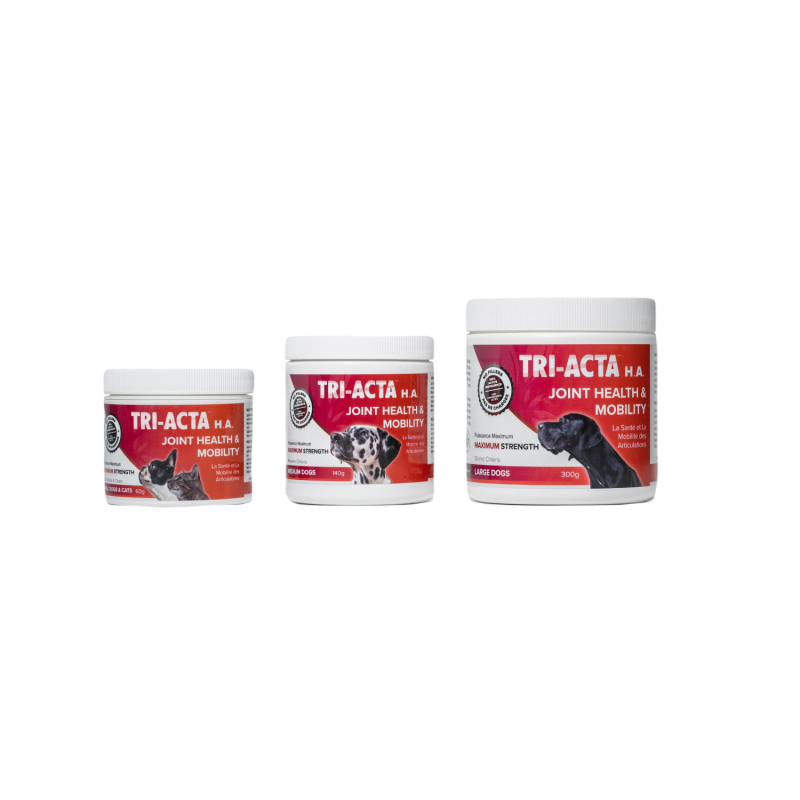
Paw Inspections
Make checking your dog’s paws a routine after walks or runs. Catching small cuts, cracks, or swelling early prevents them from turning into bigger problems.
Long-Term Care for Healthy Carpal Pads

Caring for carpal pads is ongoing maintenance, just like brushing teeth or trimming nails.
Here are some tips for keeping your dog’s carpal pads resilient so they can handle the wear and tear of an active life:
- Moisturizers and balms: Just like our hands dry out in winter, dog pads can crack without protection. Paw balms help lock in moisture, prevent splitting, and keep the skin flexible enough to absorb shock.
- Supplements for joint and connective tissue health: Pads don’t work alone. Strong connective tissue and healthy joints reduce strain on the pads, while resilient pads protect joints from impact. Supplements create a two-way safety net that keeps your dog moving comfortably.
- Exercise routines to reduce strain: Variety is your friend. Mixing up exercise surfaces, like grass, dirt, and pavement, prevents repetitive wear. High-impact activities should be balanced with low-impact options like swimming or controlled walks.
At the end of the day, joint health and paw integrity are inseparable. Weak joints shift more pressure onto pads, and injured pads force joints to absorb more impact. Supporting both ensures your dog doesn’t just walk, run, jump, and skid into their senior years with confidence.
Integricare’s supplements strengthen joints and connective tissue, giving your dog a solid foundation from the inside out while you protect the pads from the outside in.
Strong Pads, Strong Joints, Strong Dog
The carpal pad dog might look like a small detail, but it plays a starring role in how your dog moves. It’s the unsung hero that cushions landings, keeps turns sharp, and prevents slips on rugged terrain.
Most carpal pad problems can be managed or even prevented with a bit of consistency, routine paw checks, and the right products that support skin and joint health.
Bottom line: healthy pads, healthy joints, happy dog. Support them now, and you’ll enjoy more walks, more play sessions, and more of those full-speed zoomies that make life with a dog so much fun.
Ready to give your dog long-term mobility support? Order TRI-ACTA online or find a store near you.
TRI-ACTA for Pets
A proactive approach for developing and younger adult pets to maintain optimal joint health mobility, minimize inflammation and fend off age-related ailments.

Newsletter Signup
Subscribe to our newsletter to receive the latest news and exclusive offers.
.jpg?height=2000&name=Cliick_Integricare-DISPLAY-REVISEDV2%20(1).jpg)
Proactive & Therapeutic Joint Supplements
When given daily, Integricare joint supplements recover bone and joint injuries faster and help prevent mobility injuries from happening in the first place.

